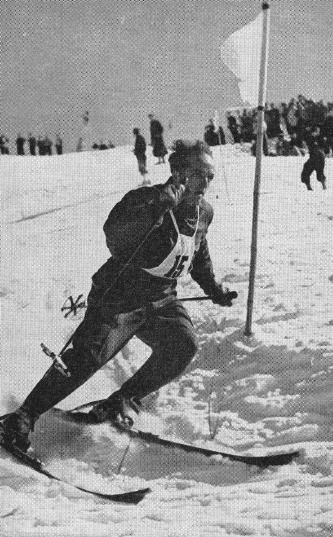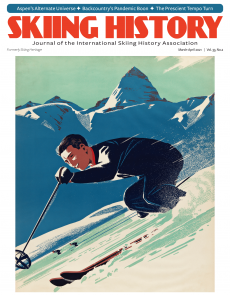SKIING HISTORY
Editor Greg Ditrinco
Consulting Editor Seth Masia
Art Director Edna Baker
Editorial Board
Seth Masia, Chairman
John Allen, Andy Bigford, John Caldwell, Jeremy Davis, Kirby Gilbert, Paul Hooge, Jeff Leich, Bob Soden, Ingrid Wicken
Founding Editors
Morten Lund, Glenn Parkinson
To preserve skiing history and to increase awareness of the sport’s heritage
ISHA Founder
Mason Beekley, 1927–2001
ISHA Board of Directors
Chan Morgan, Chairman
Seth Masia, President
Wini Jones, Vice President
Jeff Blumenfeld, Vice President
John McMurtry, Vice President
Chan Morgan, Treasurer
Einar Sunde, Secretary
Richard Allen, Skip Beitzel, Michael Calderone, Art Currier, Dick Cutler, Chris Diamond, David Ingemie, Joe Jay Jalbert, Rick Moulton, Wilbur Rice, Charles Sanders, Bob Soden (Canada)
Presidential Circle
Christin Cooper, Billy Kidd, Jean-Claude Killy, Bode Miller, Doug Pfeiffer, Penny Pitou, Nancy Greene Raine
Business & Events Manager
Kathe Dillmann
P.O. Box 1064
Manchester Center VT 05255
(802) 362-1667
kathe@skiinghistory.org
Membership Services
Laurie Glover
(802) 375-1105
laurie@skiinghistory.org
Corporate Sponsorships
Peter Kirkpatrick
(541) 944-3095
peterk10950@gmail.com
Bimonthly journal and official publication of the International Skiing History Association (ISHA)
Partners: U.S. Ski and Snowboard Hall of Fame | Canadian Ski Museum and Hall of Fame
Alf Engen Ski Museum | North American Snowsports Journalists Association | Swiss Academic Ski Club
Skiing History (USPS No. 16-201, ISSN: 23293659) is published bimonthly by the International Skiing History Association, P.O. Box 1064, Manchester Center, VT 05255.
Periodicals postage paid at Manchester Center, VT and at additional mailing offices. Postmaster: Send address changes to ISHA, P.O. Box 1064, Manchester Center, VT 05255
ISHA is a 501(c)(3) public charity. EIN: 06-1347398
Written permission from the editor is required to reproduce, in any manner, the contents of Skiing History, either in full or in part.
The Tempo Turn
Toni Seelos and Dick Durrance helped build the bridge to the modern carved turn by letting skis "do their magic."
Photo above: Dick Durrance at Oak Hill, Hanover, New Hampshire in 1939. Lane Memorial Library.
In 1933, 18-year-old Dick Durrance returned to the U.S. from his boarding school days in Bavaria with a secret weapon he’d acquired while on the continent: a technique he’d seen Toni Seelos use to dominate his competition in the Alps. Up until that time, the stem Christiania was the ne plus ultra of ski turns. Hannes Schneider, imperator of the most influential ski school at the time, felt that the stem christie was all just about anyone needed to navigate in a controlled manner around the slopes.
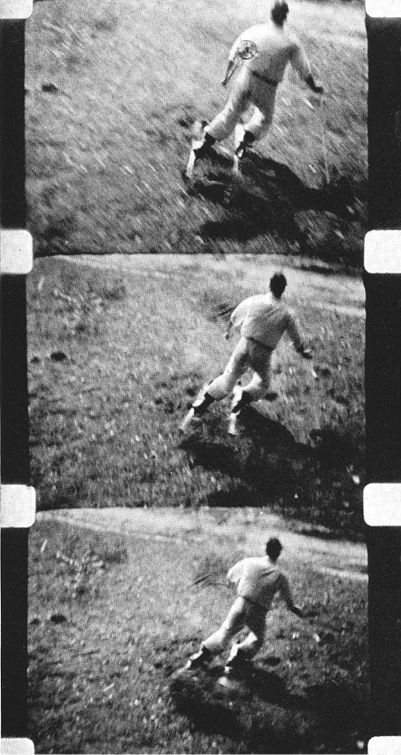
Turn on pine needles, in the 1934
Eastern Ski Annual. Ron LeMaster.
Seelos, a racer, understood that Schneider’s favorite turn was inherently a braking maneuver, and figured out how to weave his way through race courses without getting his skis so sideways, especially the stemmed ski. What Seelos came up with, and what Durrance copied, is what we might consider the Cro-Magnon species of the modern parallel turn. And Durrance was the only skier in North America who used it.
In the fall of 1933, when Durrance began winning slalom races by 20 seconds and more for Newport High School in New Hampshire, the ski press badgered him for his secret. He called it the “Tempo Turn,” and the name stuck.
The tempo turn quickly became the talk of competitive skiers. In the 1934 edition of the U.S. Eastern Amateur Ski Association’s Annual, Otto Schniebs and John W. MCrillis wrote an article, “The High Speed Turn,” in which they dissected Durrance’s technique. In the text they referred to them as “high-speed turns,” but included a print of some movie frames of him skiing on pine needles and captioned as ‘a tempo.’” (Another article in the annual titled “Pine Needle Skiing,” by Henry E. Mahoney, describes the Newport Ski Club’s slalom and jumping training on the surface.)
What’s in a Name
As Durrance described it, the tempo turn was specifically the turn as Seelos executed it: in a tall stance with the feet close together. Durrance also said that particular style didn’t suit him well, and that he went on to develop a technique with a lower, feet-apart posture in which he was more stable.
Other prominent people in U.S. skiing didn’t bother to make the distinction. All turns made at speed with the skis parallel were tempo turns. Schniebs and McCrillis, in their book Modern Ski Technique, have a section titled “High-speed (Tempo) Turn” and in the 1936 book Skiing by Charles Proctor and Rockwell Stephens, there is a section titled “High-Speed Christiania (Tempo Turn).”
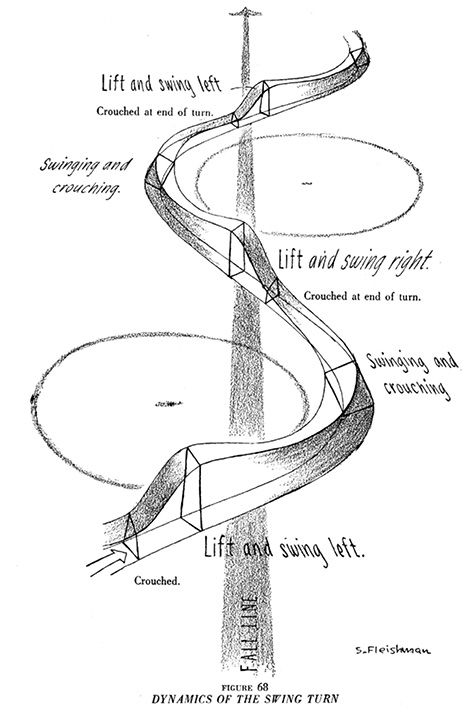
the 1934 Eastern Ski Annual.
Up to this point, tempo turns were mostly considered a tool for racers and daredevils. The name “high-speed” said it all. Schniebs and McCrillis even warned that “The turn cannot be done without considerable speed.”
Then, in 1938, Benno Rybizka’s The Hannes Schneider Ski Technique presented us with “Parallel Christiania (Tempo Turn).” Finally, we had a name that was not only unintimidating, it was more descriptive.
Aspirational Turns
All avid skiers now had a technique to which they could aspire. And, not unimportantly, one that was clearly identifiable: It was pretty easy to see if you or your friends could make it down the hill without stemming.
The tempo turn wasn’t completely subsumed by the parallel turn, though. Fred Iselin and A. C. Spectorsky, in their 1947 book Invitation to Skiing, a well-illustrated and comprehensive instructional work based primarily on the Arlberg system, said “every tempo turn is a parallel turn, but not every parallel christie is a tempo turn.”
Their treatment of the tempo turn puts it, in its intent and execution, squarely in the category that Durrance did. It’s for going fast, and getting the ski to do the turning, not the skier. There wasn’t a big windup followed by upper-body rotation in the direction of the turn. Rather, you lean forward and toward the center of the turn, and let the skis do their magic. In this regard we might expand our view of the historical significance of the tempo turn to include being the progenitor of the carved turn: the aspirational turn of the 21st Century.
Dick Durrance himself would probably agree. In The Man on the Medal, John Jerome’s great biography, Durrance said, “With nothing but a weight shift, you could cut a carved turn, letting the camber of the ski do the turning for you. I called it the tempo turn
for some reason, and thought, ‘Boy, this is really the ticket.’” 
SKI LIFE
SKI Magazine, October 1973
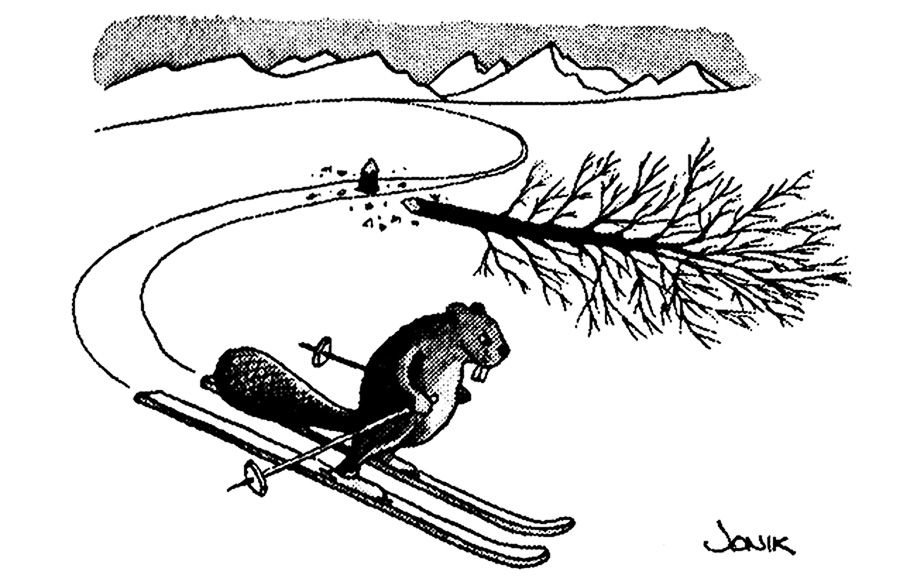

Table of Contents

Corporate Sponsors
ISHA deeply appreciates your generous support!
WORLD CHAMPIONSHIP ($3,000 AND UP)
Gorsuch
Polartec
WORLD CUP ($1,000)
Aspen Skiing Company
BEWI Productions
Bogner
Boyne Resorts
Dale of Norway
Darn Tough Vermont
Dynastar | Lange | Look
Fairbank Group: Bromley, Cranmore, Jiminy Peak
Gordini USA Inc. | Kombi LTD
HEAD Wintersports
Hickory & Tweed Ski Shop
Intuition Sports, Inc.
Mammoth Mountain
Marker-Volkl USA
Outdoor Retailer
Rossignol
Ski Area Management
Ski Country Sports
Snowsports Merchandising Corporation
Sport Obermeyer
Sports Specialists, Ltd.
Sun Valley Resort
Vintage Ski World
Warren and Laurie Miller
World Cup Supply, Inc.
GOLD ($700)
Race Place | BEAST Tuning Tools
The Ski Company (Rochester, NY)
Thule
SILVER ($500)
Alta Ski Area
Boden Architecture PLLC
Dalbello Sports
Ecosign Mountain Resort Planners
Fera International
Holiday Valley
Hotronic USA, Inc. | Wintersteiger
MasterFit Enterprises
McWhorter Driscoll, LLC
Metropolitan New York Ski Council
New Jersey Ski & Snowboard Council
NILS, Inc.
Russell Mace Vacation Homes
Schoeller Textile USA
Scott Sports
Seirus Innovations
SeniorsSkiing.com
Ski Utah
Swiss Academic Ski Club
Tecnica Group USA
Trapp Family Lodge
Western Winter Sports Reps Association
World Pro Ski Tour

